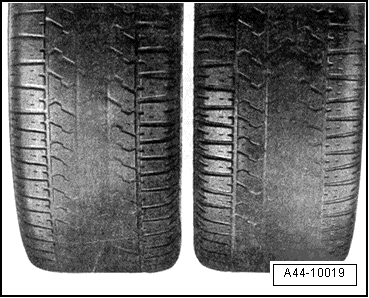Volkswagen Polo Service & Repair Manual: Tire Wear, Center
| This wear pattern is found on drive wheels on high-powered
vehicles that often drive long stretches at high speed. |
| At high speeds, the centrifugal force increases the tire
diameter at the center of the tread more than at the shoulders
of the tire. The drive forces from the center area of the tread
are transferred to the road surface. This is reflected in the
wear pattern. |
| These effects can appear especially extreme on wide tires. |
| Reducing the Tire Pressure is Not an Effective Remedy for
this Wear Pattern. |
 WARNING
WARNING
| For safety reasons, tire pressure must never be
lowered below specified pressure under any
circumstances. |
|
| A largely even wear pattern can be achieved if tires are
changed in a timely manner from the tractive to the non-tractive
axle. |
|
|
|
| Typical wear pattern of tires on the tractive axle of
high-powered vehicles. |
| The increased wear at the tread center is caused by stresses
related to the centrifugal force of the tire and the
transmission of traction forces. |
|
|

|
Diagonal wear spots on tires
Diagonal wear spots run at an angle of approximately 45°
with respect to the plane of circumference.
...
For all four wheels use only tires of the same construction
type, and tread.
Always use tires with the deepest tread depth on the front
a ...
Other materials:
Checking the coolant level and refilling coolant
Fig. 139 In the engine compartment: mark
on the coolant expansion tank
Fig. 140 In the engine compartment: coolant
expansion tank cap
First read and observe the introductory information
and safety warningsThe warning lamp for the engine coolant will light up
if the engine coolant level i ...
Refresh Charging with Battery Charger -VAS5903
Special tools and workshop equipment
required
Battery Charger -VAS5900-
WARNING
Risk of injury. Follow all Warnings and Safety
Precautions. Refer to
→ ...
Wax Spray -D 322 100 M2
Definition:
Wax Spray -D 322 100 M2-
Edition 01/2011
Product Description
Wax Spray -D 322 100 M2- is a long-term anti-corrosion
agent. After drying, the product forms a light ...
© 2016-2026 Copyright www.vwpolo.net

 Diagonal Washouts
Diagonal Washouts Permitted Tread Depth - Variance
Permitted Tread Depth - Variance
 WARNING
WARNING